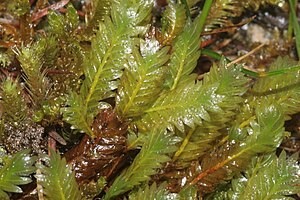Hair fern-like split tooth moss
| Hair fern-like split tooth moss | ||||||||||||
|---|---|---|---|---|---|---|---|---|---|---|---|---|

Hair fern-like split tooth moss ( Fissidens adianthoides ) |
||||||||||||
| Systematics | ||||||||||||
|
||||||||||||
| Scientific name | ||||||||||||
| Fissidens adianthoides | ||||||||||||
| Hedw. |
The hair fern-like split tooth moss ( Fissidens adianthoides ) is a species of deciduous moss from the family Fissidentaceae .
features
The hair fern-like split tooth moss grows in loose, green or dark green to brownish green lawns. The sturdy and sparsely branched shoots are about 2 to 10 centimeters long and densely leafed in two rows. The tongue-shaped to lanceolate leaves are narrowed to a sharp point. Towards the tip of the leaf they are irregularly serrated on the edges. The upper leaf blade part is usually shorter than the sheath part. The leaf vein usually ends just before the leaf tip.
The single-layer lamina cells are somewhat opaque, rounded to rounded and angular and about 12 to 20 µm in size. At the leaf margins the cells in 2 to 4 rows are somewhat lighter and thicker-walled.
The reddish, up to 3 centimeters long seta arises in the middle part of the rung and carries the slightly curved, inclined to horizontal spore capsule. The capsule lid has a long crooked beak. Spores are almost smooth to finely papillary and 14 to 24 µm in size. Sporophytes are not infrequently formed, spore maturity is from late autumn to spring.
The plants are monoecious or dioecious .
Location claims and distribution
The moss grows on wet, base-rich, often calcareous to slightly acidic, light to partially shaded locations: swamps, fens, wet meadows, ditches, spring corridors, waterfalls, banks of bodies of water.
It occurs in Europe, Asia, North Africa, the Azores, Canary Islands and Madeira, in North and South America, Australia and New Zealand. In Central Europe it is widespread from the lowlands to the subalpine level, but not often.
Others
This species of split-toothed moss is one of the largest Central European species of the genus . It is similar to the comb-toothed moss ( Fissidens dubius ), but differs from it, among other things, by different location requirements, the larger growth form and larger leaf cells.
Due to the draining of wetlands and other drainage measures in recent decades, the species is generally in decline.
literature
- Ruprecht Düll , Barbara Düll-Wunder: Determine mosses easily and reliably. An illustrated excursion guide to the types of Germany and neighboring countries. Quelle & Meyer, Wiebelsheim 2008, ISBN 978-3-494-01427-2 .
- Jan-Peter Frahm , Wolfgang Frey : Moosflora (= UTB . 1250). 4th, revised and expanded edition. Ulmer, Stuttgart 2004, ISBN 3-8252-1250-5 .
- Martin Nebel, Georg Philippi (ed.): The mosses of Baden-Württemberg. Volume 1: General part, special part (Bryophytina I, Andreaeales to Funariales). Ulmer, Stuttgart 2000, ISBN 3-8001-3527-2 .

